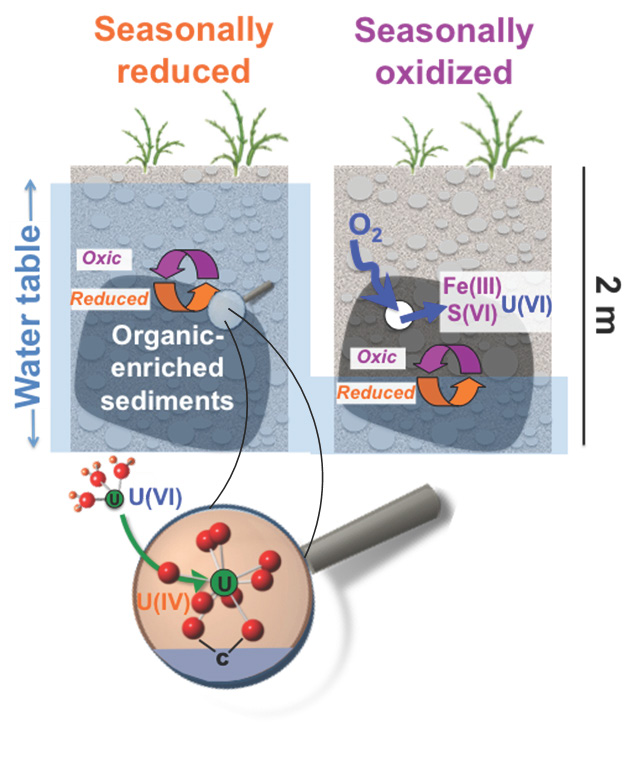A Regional Model for Uranium Redox and Mobility
01/19/2017

Anoxic organic-enriched sediments strongly accumulate uranium as U(IV), sulfide, and other reduced species. Seasonal reduction-oxidation (redox) cycling triggered by changing water tables can intermittently mobilize these species. [Courtesy Vincent Noël and John Bargar, Stanford Synchrotron Radiation Lightsource, SLAC National Accelerator Laboratory]
The Summary
Uranium (U) contamination stubbornly persists as a challenging and costly water quality concern at former uranium ore processing sites across the Upper Colorado River Basin (UCRB). Plumes at these sites are not self-attenuating via natural flushing by groundwater as originally expected. Recent studies at the Rifle, Colo., legacy site suggest that organic-enriched anoxic sediments create conditions that promote reduction of U(VI) to relatively immobile U(IV), causing it to accumulate locally under persistently saturated and anoxic conditions. However, incursion of oxidants into reduced sediments could transform contaminants, allowing these sediments to act as secondary sources of uranium. Oxidant incursions take place during periods of changing water tables, which occur in UCRB throughout the year. If these sediments were regionally common in the UCRB and exposed to varying reduction-oxidation (redox) conditions, then they could contribute to maintaining the longevity of regional uranium plumes.
To investigate these issues, researchers examined the occurrence and distribution of reduced and oxidized iron (Fe), sulfur (S), and U species in sediment cores spanning dry and oxic to wet and reduced conditions at three different UCRB sites. Detailed molecular characterization involved chemical extractions, X-ray absorption spectroscopy (XAS), Mössbauer spectroscopy, and X-ray microspectroscopy. This work demonstrates that anoxic organic-enriched sediments occur at all sites, strongly accumulate sulfides and U, and are exposed to strong seasonal redox cycles. Uranium was found to be present as U(IV) complexed to sediment-associated organic carbon and possibly to mineral surfaces. This finding is significant because complexed U(IV) is relatively susceptible to oxidative mobilization. Sediment particle size, organic carbon content, and pore saturation control redox conditions in sediments and thus strongly influence Fe, S, and U biogeochemistry. These findings help to illuminate the mechanistic linkages between hydrology, sediment texture, and biogeochemistry. They further provide enhanced contextual and conceptual underpinnings to support reactive transport modeling of uranium, other contaminants, and nutrients in redox-variable floodplains—a subject of importance to BER research missions. Cyclic redox variability has major implications for mobility of carbon (C), nitrogen (N), and metal contaminants in groundwater and surface waters. Redox-variable, organic-enriched sediments mediate the mobility of C, N, Fe, S, U, and metal contaminants regionally in the UCRB. Organic-enriched sediments were established to regionally mediate groundwater quality within the UCRB.
Funding
For “Understanding controls on redox processes in floodplain sediments of the Upper Colorado River Basin.” Sci. Total Environ. DOI: 10.1016/j.scitotenv.2017.01.109: Supported by the Office of Biological and Environmental Research (OBER) Climate and Environmental Sciences Division, U.S. Department of Energy (DOE) Office of Science, through the SLAC National Accelerator Laboratory (SLAC) Science Focus Area (SFA) program and by DOE Office of Science’s Office of Basic Energy Sciences-(OBES) through its support for Stanford Synchrotron Radiation Lightsource (SSRL) at SLAC. SSRL and SLAC are supported by OBES, DOE Office of Science, under Contract No. DE-AC02-76SF00515 and OBER, and by the National Institutes of Health’s (NIH) National Institute of General Medical Sciences (NIGMS; including P41GM103393). Material partially based on work supported through Lawrence Berkeley National Laboratory’s (LBNL) Genomes-to-Watershed Scientific Focus Area (SFA). The DOE Office of Science’s, OBER-funded work under contract DE-AC02-05CH11231 (LBNL; operated by the University of California).
For “Redox constraints over U(IV) mobility in the floodplains of Upper Colorado River Basin.” Environ. Sci. Technol. DOI: 10.1021/acs.est.7b02203: X-ray fluorescence spectrometry with a XEPOS (Spectro X Lab) x-ray fluorescence spectrometer. x-ray synchrotron powder x-ray diffraction (SR-XRD) performed on sediments as part of this study. Porewater and groundwater samples analyzed for their element composition using high-resolution inductively coupled plasma mass spectroscopy (HR-ICP-MS), X-ray Absorption Spectroscopy (XAS). U LII-edge x-ray absorption near-edge structure (XANES) spectroscopy used to determine uranium (U) oxidation states. Research supported by the Office of Biological and Environmental Research (OBER) Climate and Environmental Sciences Division, U.S. Department of Energy (DOE) Office of Science, through the SLAC National Accelerator Laboratory (SLAC) Science Focus Area (SFA) program and by the Office of Basic Energy Sciences (OBES), DOE Office of Science, through its support for Stanford Synchrotron Radiation Lightsource (SSRL) at SLAC. SSRL and SLAC are supported by OBES, DOE Office of Science, under Contract No. DE-AC02-76SF00515; OBER; and National Institutes of Health’s (NIH) National Institute of General Medical Sciences (NIGMS; including P41GM103393). Coring and field site access provided by DOE’s Legacy Management. Field work at the Rifle site partially supported by the Lawrence Berkeley National Laboratory’s (LBNL) Genomes-to-Watershed SFA. The DOE Office of Science OBER-funded work is under contract DE-AC02-05CH11231 (LBNL, operated by the University of California). The Canadian Light Source (CLS) is supported by Natural Sciences and Engineering Research Council of Canada, National Research Council Canada, Canadian Institutes of Health Research, Province of Saskatchewan, Western Economic Diversification Canada, and University of Saskatchewan.
Related Links
- BER Resource: Structural Molecular Biology Resource
- Feature Story: A regional model for uranium redox and mobility
References
Noël, V., K. Boye, R.K. Kukkadapu, S. Bone, J.S. Lezama Pacheco, E. Cardarelli, N. Janot, S. Fendorf, K.H. Williams, and J.R. Bargar. 2017. “Understanding controls on redox processes in floodplain sediments of the Upper Colorado River Basin.” Sci. Total Environ.603–604, 663–675. [DOI:10.1016/j.scitotenv.2017.01.109]
Noël, V., K. Boye, J.S. Lezama Pacheco, S.E. Bone, N. Janot, E. Cardarelli, K.H. Williams, and J.R. Bargar. 2017. “Redox Controls over U(IV) mobility in the floodplains of Upper Colorado River Basin.” Environ. Sci. Technol. 51(19), 10954–64. [DOI:10.1021/acs.est.7b02203]
